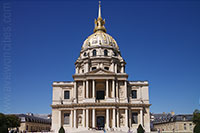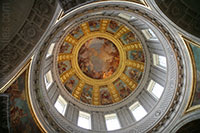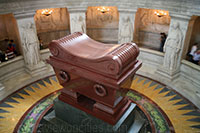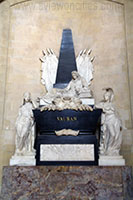The royal chapel of the Invalides complex is the location of the tomb of one of France's favorite native sons.
The Invalides Complex
The complex of buildings known as Les Invalides sits in Paris's 7th arrondissement
and consists of museums and monuments related to the military history
of France. The most recognizable and well-known part of Les Invalides is
the Dôme des Invalides,
 a gold-domed building now used as a burial site for a number of the country's war heroes.
a gold-domed building now used as a burial site for a number of the country's war heroes.

Dôme des Invalides
Its History
Proposed by Louis XIV in 1670 as a home for
"invalids" - disabled and impoverished war veterans, Les Invalides was
designed by Libéral Bruant and completed in 1676.
That same year King Louis XIV - the Sun King -
charged architect Jules Hardouin Mansart with the task of creating a
separate private chapel at the Invalides for exclusive use of the royal
family. It is this gold-domed church, completed in 1708 by de Cotte
after Mansart died, that many
 individuals recognize. Inspired by Rome's St. Peter's Basilica, this chapel, known as Église du Dôme, is considered one of the world's most exciting examples of French Baroque architecture.
individuals recognize. Inspired by Rome's St. Peter's Basilica, this chapel, known as Église du Dôme, is considered one of the world's most exciting examples of French Baroque architecture.

The painted dome
The dome itself is 107 meters high (351 ft),
making it one of the tallest monuments in Paris, and was centrally
placed in order to dominate the court of honor - one of 15 courtyards at
the complex, designed for military parades. The inside of the dome was
painted by Charles de La Fosse, disciple of 18th century well-known
French painter, Charles Le Brun.
Napoleon's Tomb
Napoleon Bonaparte,
 whose
last wish was to be buried at the banks of the Seine River, died on the
island of St. Helena and was buried there until King Louis-Philippe
decided to have his body exhumed and returned to Paris in 1840. He chose
to have him entombed at Les Invalides.
whose
last wish was to be buried at the banks of the Seine River, died on the
island of St. Helena and was buried there until King Louis-Philippe
decided to have his body exhumed and returned to Paris in 1840. He chose
to have him entombed at Les Invalides.

Napoleon's Tomb
In order to accommodate the tomb, architect Louis
Visconti had to redesign the high altar of the domed church. Upon
completion in 1861, the remains of Napoleon's body were then placed in 6
coffins inside a tomb, which was fashioned from red Finnish porphyry
with a green granite base, and placed inside the crypt.
A dozen large figures are arranged around the tomb, intended to
 represent
Napoleon's victories. An accompanying statue of the French leader
himself, dressed in coronation robes, stands nearby and measures more
than 8 feet high (2.4 m), in stark contrast to the emperor's diminutive
size.
represent
Napoleon's victories. An accompanying statue of the French leader
himself, dressed in coronation robes, stands nearby and measures more
than 8 feet high (2.4 m), in stark contrast to the emperor's diminutive
size.

Vauban Memorial
Also buried at Invalides are several members of
Napoleon's family as well as a number of prominent French military
leaders and war heroes.
The memorial of Sébastien le Prestre de Vauban, marshal of King Louis XIV's army, was installed here in 1808 at Napoleon's request. The monument contains an urn with the ashes of Vauban. Another large monument in the Dôme des Invalides is the bronze tomb of marshal Ferdinand Foch, commander of the allied armies at the end of the first World War.
The memorial of Sébastien le Prestre de Vauban, marshal of King Louis XIV's army, was installed here in 1808 at Napoleon's request. The monument contains an urn with the ashes of Vauban. Another large monument in the Dôme des Invalides is the bronze tomb of marshal Ferdinand Foch, commander of the allied armies at the end of the first World War.
No comments:
Post a Comment